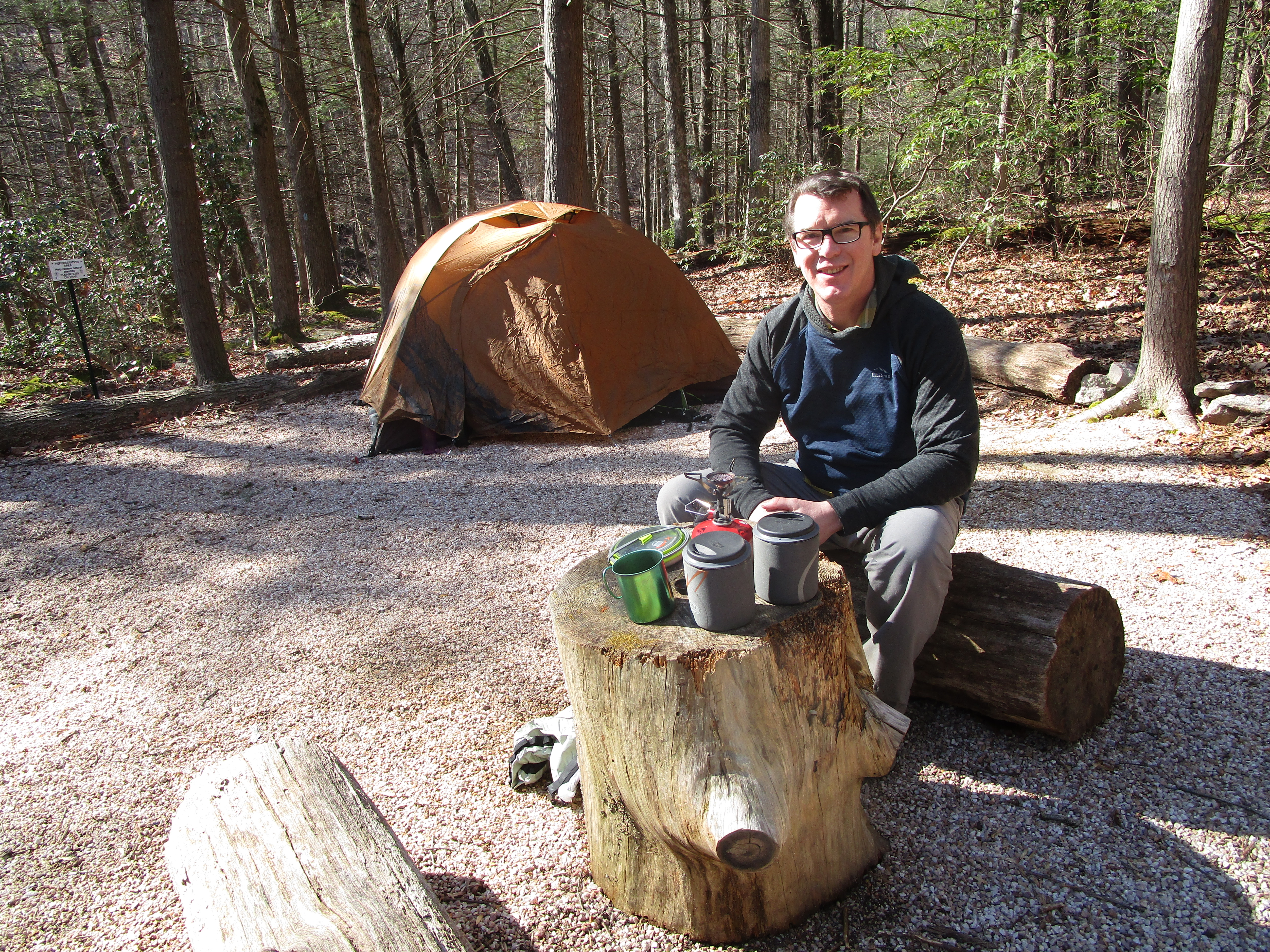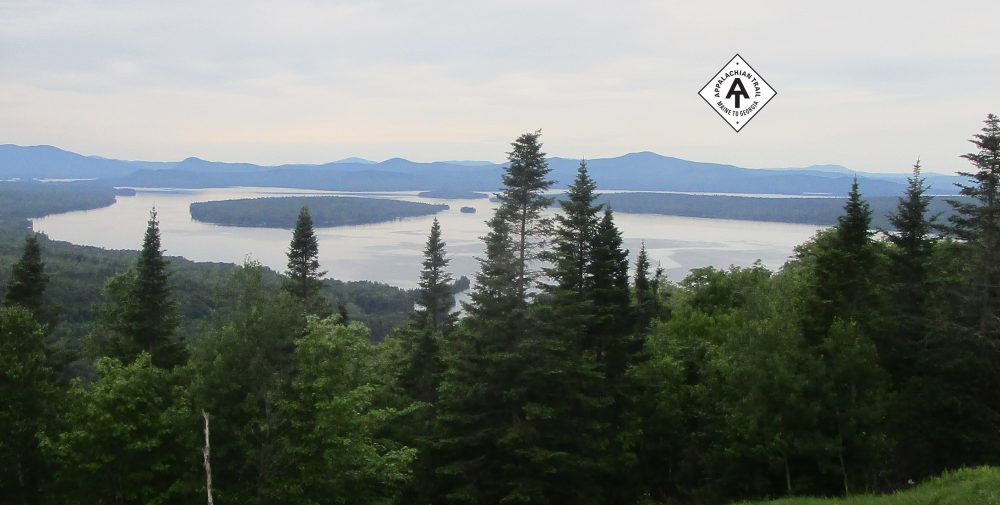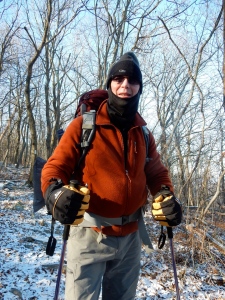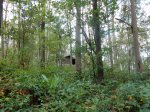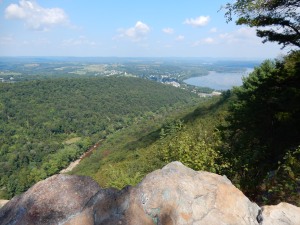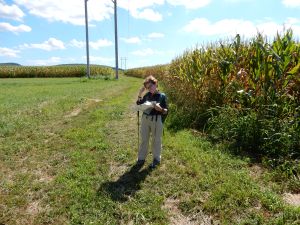Day One: Port Clinton to Windsor Furnace Shelter
Regardless of freezing temperatures, Karen and I decided to close the old and bring in the new year, 2016, on the Appalachian Trail. We returned to Port Clinton and parked off of Broad Street. There we picked up the trail, passed under highway 61, and clambered up Blue Mountain once again. On top of the ridge, we had the usual rocky path before us and no noteworthy obstacles. The trail does descend to Pocohontas Campsite and Spring only to reascend shortly thereafter—a rather pointless down and up for us. Again, the trail descends a bit to Minnehana Spring. Both springs are on the KTA map, and both are active, though Pocohontas is the better of the two for gathering water. What is not on the map is a rapidly flowing creek between Minnehana Spring and Furnace Creek, above Hamburg Reservoir. Had we urgently needed water, this would have been the best source yet. See the photo below.
Broad Street. There we picked up the trail, passed under highway 61, and clambered up Blue Mountain once again. On top of the ridge, we had the usual rocky path before us and no noteworthy obstacles. The trail does descend to Pocohontas Campsite and Spring only to reascend shortly thereafter—a rather pointless down and up for us. Again, the trail descends a bit to Minnehana Spring. Both springs are on the KTA map, and both are active, though Pocohontas is the better of the two for gathering water. What is not on the map is a rapidly flowing creek between Minnehana Spring and Furnace Creek, above Hamburg Reservoir. Had we urgently needed water, this would have been the best source yet. See the photo below.
 It was late in the afternoon when we arrived at Windsor Furnace Shelter, and having the place to ourselves, we decided to lay out our sleeping bags within the shelter itself. This is the first time that we didn’t pitch our tent. Soon the frigid weather made itself felt, and so we quickly slipped into our long underwear and winter clothing. Hardly had we done so when we got two visitors, Mike and his son Wyatt. They were going to set up their tent further down the trail, but first stopped to introduce themselves. Later, after the sun had set, they again came by for some New Year’s Eve fellowship. From the sixteen-year-old Wyatt I learned, “There is no such thing as bad weather, only bad gear.”
It was late in the afternoon when we arrived at Windsor Furnace Shelter, and having the place to ourselves, we decided to lay out our sleeping bags within the shelter itself. This is the first time that we didn’t pitch our tent. Soon the frigid weather made itself felt, and so we quickly slipped into our long underwear and winter clothing. Hardly had we done so when we got two visitors, Mike and his son Wyatt. They were going to set up their tent further down the trail, but first stopped to introduce themselves. Later, after the sun had set, they again came by for some New Year’s Eve fellowship. From the sixteen-year-old Wyatt I learned, “There is no such thing as bad weather, only bad gear.”

Day Two: Windsor Furnace Shelter to Eckville Shelter
Karen and I stayed toasty warm in our sleeping bags and liners. In fact, so comfortable were we, buried in the darkness of our bags, that we failed to notice the morning light and didn’t arise until 8:30. Within an hour, we were back on the trail.
As we scrambled up and over the boulders at Pulpit Rock, Mike and Wyatt caught up with us. This was as far as they were going. They were the first to whom we wished a happy New Year. Karen and I paused to take a picture of ourselves before the overlook and, then, quickly got on our way. Soon we arrived at the Pinnacle, and as we arrived the temperature suddenly dropped and snow flurries started to fall. A dozen or so day-hikers arrived just behind us. We carefully found our way across the rocks to the overlook, took in the view, but didn’t stay to fully appreciate the spectacle. A frigid breeze and darkening clouds prompted us to be on our way.
New Year. Karen and I paused to take a picture of ourselves before the overlook and, then, quickly got on our way. Soon we arrived at the Pinnacle, and as we arrived the temperature suddenly dropped and snow flurries started to fall. A dozen or so day-hikers arrived just behind us. We carefully found our way across the rocks to the overlook, took in the view, but didn’t stay to fully appreciate the spectacle. A frigid breeze and darkening clouds prompted us to be on our way.

From the Pinnacle to Eckville is the easiest AT in PA. The path is, until perhaps a mile from Eckville, broad and relatively flat and smooth. The only drawback is that the trail is wet and muddy up until it reaches a junction with the blue trail favored by day-hikers. Although the map doesn’t show it, the trail crosses Pine Creek over a bridge, and shortly thereafter it darts back into the woods. It emerges at Hawk Mountain Road.  There is no sign to indicate that Eckville Shelter is just down the road a ways. Karen and I, expecting a sign and a blue trail to lead us to the shelter, continued to hike another half a mile before we came to the conclusion that we must have missed it. Retracing our steps was a hard thing to do, especially at the end of the day, and on our way back to Hawk Mountain Road, we picked out a spot to set up our tent should we fail to find the shelter. Yet, find it we did. There was a hardly noticeable blue blaze down the road, pointing us in the direction of a white house, behind which is the shelter.
There is no sign to indicate that Eckville Shelter is just down the road a ways. Karen and I, expecting a sign and a blue trail to lead us to the shelter, continued to hike another half a mile before we came to the conclusion that we must have missed it. Retracing our steps was a hard thing to do, especially at the end of the day, and on our way back to Hawk Mountain Road, we picked out a spot to set up our tent should we fail to find the shelter. Yet, find it we did. There was a hardly noticeable blue blaze down the road, pointing us in the direction of a white house, behind which is the shelter.

We were Eckville Shelter’s first occupants of 2016. The place had been winterized, so there was no electricity and the privy was closed, but the spigot coming from the house provided us with water, and the four walls kept us out of the wind. The place has two sets of bunk beds on one side, and another set and a table on the other side. Soon after setting ourselves up, and while we were preparing our dinner on the picnic table outside, the associate caretaker and ridge-runner, Scott B., appeared. We thanked him for his hospitality, and he shared with us some of the history of the local trail. Shortly after the sun had set, we gladly slipped back into the warmth of our sleeping bags.
Day Three: Eckville Shelter to PA 309
Saturday morning we arose at 7:00, after another twelve-hours’ sleep. The temperature had dropped into the 20s over night, and the sun had yet to make itself felt. After a breakfast of hot oatmeal, we donned our packs and hit the trail. Ahead of us was our highest ascent of this trip, again up Blue Mountain. Once upon the ridge, the trail became rockier than we had experienced during the first two days. We scrambled up Dan’s Pulpit and, then again, we scrambled across the Balanced Rocks.

After five-and-a-half hours of hiking, we finally reached Allentown Shelter. This is a much nicer shelter than Windsor Furnace. It is set higher off the ground, and has a bunk platform on each side of the interior, and a table built into the two sides of the exterior. We made ourselves a hot lunch and basked for a few minutes in the near 40-degree warmth of the sun.

From Allentown Shelter, the northbound trail follows, for about two miles, an old, abandoned dirt road, which allows for faster and less treacherous walking. By this time, the bottoms of my feet ached from the constant pressure of rock edges, so I was ready for this change. So, too, was Karen, whose back was now aching. In an hour and twenty minutes, we covered the last four miles to PA 309.
It had been a delightful and memorable adventure. What a great way to begin the new year!

